Uniformed Officer Use in Work Zones
Printable Version [PDF 1.04MB]
You will need the Adobe Reader to view this PDF.
Contact Information: WorkZoneFeedback@dot.gov
February 1, 2012
slide 1
Uniformed Officer Use in Work Zones
- FHWA Final Rule
- 23 CFR Part 630, subpart K.
- Effective Date 12/05/08
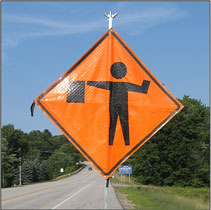
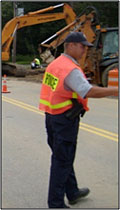
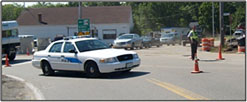
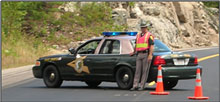
slide notes
Based on the Work Zone Safety and Mobility Final Rule, effective 4 years ago, States now have to consider all those who are associated with work zone activities.
slide 2
FHWA Rule 630.1106(c)
Uniformed Law Enforcement Policy
- "Each agency, in partnership with FHWA, shall develop a policy addressing the use of uniformed law enforcement on Federal-Aid highway projects."

slide notes
This includes Uniformed Officers.
slide 3
FHWA Rule 630.1106(c)
Uniformed Law Enforcement Policy Components
- When & how officers are used
- Agreements & Communication between DOT and law enforcement agencies
- Reimbursement procedures
- Training
slide notes
The Final Rule changed FHWA's Regulations and had several components to it:
- When and how officers will be used
- Agreements between Agencies and Communications channels
- How officers are to be reimbursed
- But the 800 lb gorilla was/is the training!
slide 4
Law Enforcement Officer (LEO) Training
What do we tell them?
How do we tell them?
How do we track them?
slide notes
When considering training, the three questions that came to us:
- What are you going to include in the training? What's important for them to know? What do they need to know?
- How do we deliver training to them? What format? Who does it?
- Then, once the officers are trained, how are we going to know that the particular officers that show up at a site are trained and that training hasn't expired?
We had some work ahead of us!
slide 5
Law Enforcement Officer (LEO) Training (cont'd)
What do we tell them?
- Aspects of a work zone?
- Traffic control procedure?
- What to do and when?
- Where do we start?
slide notes
What should we include in the training?
- Should we include aspects of work zone traffic control?
- How about how the traffic control is developed?
- What to do and when seems obvious, so we will include that, but
- Where do we start??
slide 6
Law Enforcement Officer (LEO) Training (cont'd)

slide notes
Well, it just so happens that FHWA did a lot of the work for us. They, or their contractor, created a training course for law enforcement in work zones.
So, we quickly (and wisely I might add) decided to adopt the FHWA training course. At least for the most part.
slide 7
Law Enforcement Officer (LEO) Training (cont'd)
FHWA Training Content:
- Introduction
- Roles and Responsibilities
- Understanding Work Zones
- Recommended Practices
- Applications
slide notes
The New Hampshire LEO training course basically follows the same format and has the same general content as the FHWA developed course as shown on this slide.
slide 8
WZ Traffic Control Committee
Subcommittee on Police & Flagger Training
- Reimbursement
- Policy & Guidelines on Police Use
- Training:
- Went through FHWA police material slide-by-slide
- Looked at common police use issues
- Brought in police to review and comment
slide notes
None.
slide 9
With a New Hampshire Twist
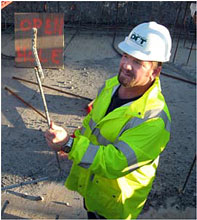
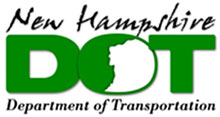
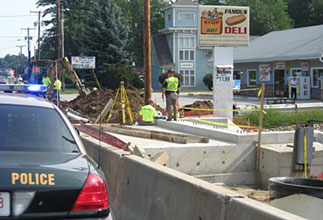
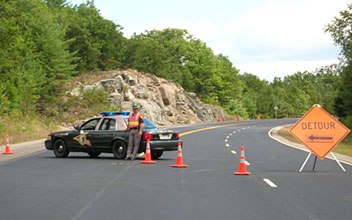
slide notes
However, the NHDOT course is customized for NH. For instance, when we talk about roles, we identify people by the terms used by NHDOT and the contractors. As an example of that, we call the State field engineer responsible for construction oversight, the "Contract Administrator." More so, we customized the training also based in the manner we normally used officers in the field, the manner in which they are contracted to work, the specific requirements for officer vehicles, and apparel, etc. Lastly, we also included slides on long-standing issues we have had with officers over the years, such as who is in control of the traffic, not moving traffic control devices because they don't know better, issues between officers and flaggers, etc.
slide 10
Law Enforcement Officer (LEO) Training
What do we tell them?
How do we tell them?
How do we track them?
slide notes
So we figured out what to tell or teach the officers. The next question that needed to be answered was, who is going to teach them.
slide 11
Law Enforcement Officer (LEO) Training (cont'd)
How?
Issues
- 4,500 police officers in the State, where do we start?
- Who does the training?
- What mechanisms are in place to train them now?
slide notes
There are many issues with how to train law enforcement officers:
- With 4,500 police officers in the State and not knowing which ones will be showing up on a project, where do we start?
- Who is going to conduct the training? It's not likely going to be engineers. We can't relate to them well, and they aren't likely to listen to us.
- What mechanisms already exist for training law enforcement? Can we leverage these existing mechanisms? Police need all kinds of training now. Where do they get it from now?
slide 12
Law Enforcement Officer (LEO) Training (cont'd)
How are they trained now?
- Police Standards and Training Council (Police Academy)
- Local Police Trainers
In-Person Training

slide notes
Police receive a lot of in-service training now on other topics related to their duties, everything from making arrests to gun safety. So we wanted to see if we could piggy back on that training methodology. What we found in New Hampshire is that police were mostly trained in two manners:
- Either by the course offered by the Police Standards and Training Council, which is the organization that runs the police academy or
- The second way law enforcement gets training now is by local training officers that were trained by the Police Standard and Training Council. Essentially, many of the police departments across the State have designated training officers who will go get trained themselves on a particular topic, then come back and be responsible for training their peers. This can work well, but it has issues in regards to ensuring consistency of training and documenting who has been trained.
These methodologies could be categorized as "In-Person Training." We were really hoping for a more remote training opposition given we had so many officers that would likely want training.
slide 13
Law Enforcement Officer (LEO) Training (cont'd)
Remote Training
- Consistent Message
- Easy to track
- Easy for LEO to take
- No DOT Personnel Time Required!
slide notes
As we were developing our own PowerPoint training from the FHWA PowerPoint slides, we knew that developing the course would be the easy part. The tough part is getting the training to such a large number of officers in every region of the State.
The idea of having a web-based course was very appealing, but we also knew that trying to do that through the State's Department of Information Technology was a non-starter.
As we were talking with police during the development of our course, one of the local Chiefs of Police talked to a local private vendor that develops online training courses. The company's name is "THE RESPONSE NETWORK." They don't just take PowerPoint slides and put them online, they create an interactive, modern, animated-style training course with the goal of really engaging their audience.
This vendor has been trying to make more inroads to the police departments in NH with his training. When the owner heard about us developing a course that would be required of all police who want to work on NHDOT work zone details, he contacted us and offered to take our training course and make an online version that could be taken by any officer anywhere at anytime. But that is not the best part; the best part is that he said he would do it for free, as long as he could charge a small fee to officers for taking the course (in the $20–$25 range). Since we pay officers to work in our work zone, we saw no issue with them having to pay a small fee for training.
slide 14
Law Enforcement Officer (LEO) Training (cont'd)
Remote Training Development

slide notes
As we were developing our own PowerPoint training from the FHWA PowerPoint slides, we knew that developing the course would be the easy part. The tough part is getting the training to such a large number of officers in every region of the State.
The idea of having a web-based course was very appealing, but we also knew that trying to do that through the State's Department of Information Technology was a non-starter.
As we were talking with police during the development of our course, one of the local Chiefs of Police talked to a local private vendor that develops online training courses. The company's name is "THE RESPONSE NETWORK." They don't just take PowerPoint slides and put them online, they create an interactive, modern, animated-style training course with the goal of really engaging their audience.
This vendor has been trying to make more inroads to the police departments in NH with his training. When the owner heard about us developing a course that would be required of all police who want to work on NHDOT work zone details, he contacted us and offered to take our training course and make an online version that could be taken by any officer anywhere at anytime. But that is not the best part; the best part is that he said he would do it for free, as long as he could charge a small fee to officers for taking the course (in the $20–$25 range). Since we pay officers to work in our work zone, we saw no issue with them having to pay a small fee for training.
slide 15
Web Based Training

slide notes
In the next few slides, I am just going to show you a few screenshots from the online course and use them to describe it and some of its benefits.
This is a screenshot of the course's modules. The modules have to be taken in order and must be completed to progress to the next one. As you can see here, I had completed the course overview, pre-assessment (test), and module #1, and I am now working on module #2. But I am locked out of the next two modules and the final assessment.
People can stop the training program at any time and restart hours, days, or weeks later at the exact point they stopped. This is great for officers who may be taking this while on duty during a slow time and, if needed, can stop suddenly and not worry about having lost what they had accomplished and having to do it again.
Note that there is a final test that participants must take and pass in order to receive a course completion certificate and have their name added to those officers available to work on NH work zones.
But not only is there a final assessment, there are actually mini-assessments at the end of each module to make sure that officers are staying alert. In fact, the "pre-assessment" works to help officers to see what kinds of things they are going to be tested on later and works to make them more attentive up front.
slide 16
Web Based Training (cont'd)

slide notes
This is a typical screen seen during the course. Though it looks busy, the way it comes off live makes it very understandable. The text pops up as the professional narrator talks through it. The narrator mostly follows the text, with a few added thoughts along the way.
Actual New Hampshire photos are used, like the photo of the NH State Police car shown in this slide that was hit in a work zone.
slide 17
Web Based Training (cont'd)

slide notes
Here is a screen at the end of a module where they would have to take a short quiz to move forward. This helps reinforce the course's content.
slide 18
Web Based Training (cont'd)

slide notes
The quizzes and the final evaluation are all multiple choice, and they provide you with immediate feedback on whether you get the questions right or not. The quizzes you can take multiple times until you get them right, but on the final evaluation, you must get 7 out of the 10 questions correct in order to pass. If you don't pass, you must take the entire course over again!
slide 19
Web Based Training (cont'd)

slide notes
The training also has graphical elements, as shown here, where the components of the Work Zone Traffic Control layout pop up on the screen as the narrator walks the participant through the basic setup of a lane closure transition setup.
Note the controls on the bottom of the screen that allow you to pause at any moment, rewind and watch again if you missed something, control the volume, etc. The controls go away until you scroll over them with your cursor.
slide 20
Web Based Training (cont'd)

slide notes
Lastly, the training has full animation features. This is a screenshot (still shot) of one of the animated "Case Scenarios" describing and showing the basic setup of a work zone lane closure with a police car positioned in the appropriate location. The animation goes through the setup of all the traffic control devices and then the position of the vehicle, with all aspects of this being narrated throughout the animation.
slide 21
Law Enforcement Officer (LEO) Training
- What do we tell them?
- How do we tell them?
How do we track them?
slide notes
None.
slide 22
Law Enforcement Officer (LEO) Training (cont'd)
Tracking
Need
- Must cover all officers trained
- Must be available all around the State
- Available 24/7
- Data must be easily searched
- Department/Agency
- Name
- Date
slide notes
None.
slide 23
Tracking Those Trained
- Web-Based Training
- Those trained on web are automatically added to the vendor's database – which is made available to DOT for validation purposes
- In-Person Training
- Tough to track – Requires extra effort by Dept.
- Certificate is given at completion of course
- Present plan is to create a State owned data base
slide notes
None.
slide 24
Final Thoughts
- Will Officers take training?
- All Officers who want to work in an NHDOT work zone as of April 1, 2013, will have to have completed this training.
- Training required every 4 Years
- What have we heard?
- Some resistance and some grumbling, but since we pay them and it is voluntary on their part, there is little they can say about this modest requirement.
slide notes
None.
slide 25
Questions?
http://lms.policecommunity.net/trn-demo/NH-Workzone-Intro-demo.html
http://lms.policecommunity.net/trn-demo/NH-Workzone-scenario-demo.html
Martin D. Calawa, PE
FHWA – NH Division
martin.calawa@dot.gov
slide notes
None.